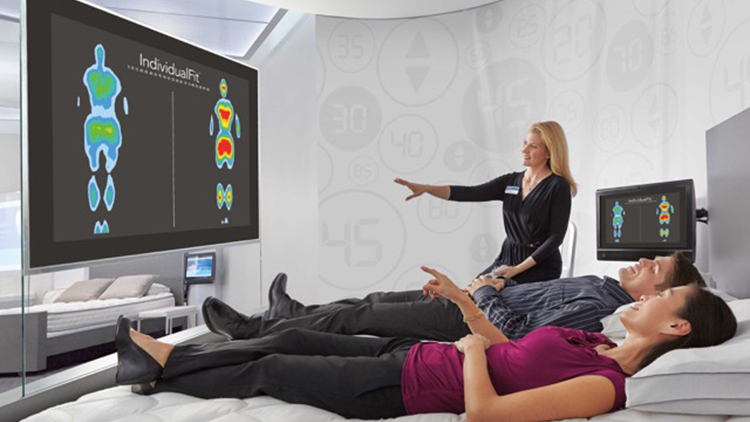It’s one of the great retail success stories.
In 1987, Sleep Number transformed the mattress industry with the simple idea that one size does not fit all. Starting from a small kiosk in a mall in Roseville, Minnesota, the company has grown to more than 500 stores, 3,800 employees, and revenues over $1.3 billion.
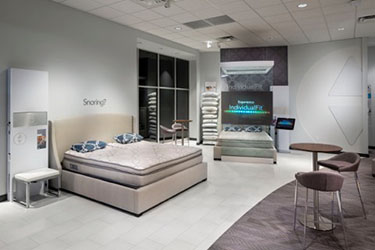
Central to the company’s success is the idea of dual adjustability, where buyers can each adjust the firmness of their side of a mattress to their own personal preference. Almost 30 years of research suggests that Sleep Number customers really do fall asleep faster, experience more deep sleep with fewer disturbances and experience greater relief from back pain than those with traditional mattresses. Yet communicating those advantages has always been a challenge, with the company’s growth tied closely to a series of major innovations in store design.
Today, when a couple visits a Sleep Number store, they go through a series of interactive experiences that communicate the advantages of the products.
The first, the IndividualFit™ 3D Imaging demonstration, asks them to try out a bed while watching a digital map that displays their bodies’ pressure points. As the fit adjusts, they can see the pressure points dissipate via large-screen visuals projected on a 95” screen at the foot of the bed. Because the screen is two-sided, others in the store can watch as well.
The custom mapping software and projection screen technology build credibility and confidence in the purchase, leaving no doubt that Sleep Number is the right choice. These enhanced demonstrations have helped the firm experience remarkably rapid growth since their introduction five years ago.
Rational and Emotional
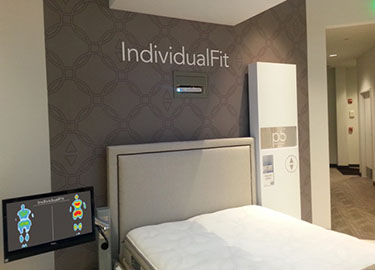
According to Angela Gearhart, Senior Director of Retail and Brand Experience, Sleep Number’s explosive growth is based on the stores’ ability to transform a purely rational shopping experience to one that maximizes both rational and emotional appeals.
“It really becomes powerful when a couple can see how different they are,” Gearhart explains. “No two people are the same size, the same weight or the same shape, and through the demo they can see as well as feel the advantages of our mattress.” The IndividualFit demonstration, featuring dual adjustability, allows each client to alleviate discomfort and find his or her Sleep Number – the ideal setting for a better night’s sleep.
“Every shopping experience is rational in that we are trying to find something we need, a solution to a problem,” Gearhart adds. “But it’s emotional, too. It’s about how the product makes us feel.
“With IndividualFit, we build credibility and confidence in the product and our people by showing how the pressure points melt away as we work together to find the perfect setting. In the process, we start to build a lifelong relationship with our customers, one that’s founded on trust.”
Unique technology
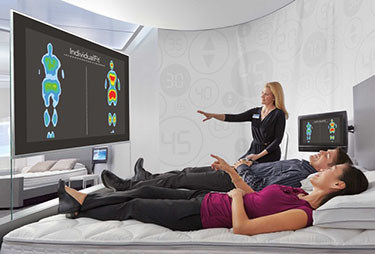
Gearhart says Sleep Number launched its first imaging-based demo back in 2004, using a sensor mat created by Xsensor Software in Calgary.
The sensors drove the 3D imaging application, which they developed, allowing an individual or couple to view the pressure map on a Windows-based computer, watching how their pressure points changed as they adjusted the mattress.
That innovation helped drive the company’s sales for the next 11 years, until in 2012, Gearhart and her team had the idea of projecting the pressure map on a large screen at the foot of the bed. The huge image transformed the demo from an individual buying experience to something that anyone in the store could see. The pressure map could now function as an attraction for new buyers – a digital signage display for those who might not be ready to commit themselves to a demonstration.
The first stores to get the reinvented demo used traditional, lamp-based projectors, but Gearhart says her team soon realized the difficulty of maintaining those systems. Not only did the lamps need replacement at least twice a year, but the picture quality deteriorated rapidly as the lamps and projectors aged.
In 2013, screen company and design consultant Spyeglass of Minneapolis suggested that the group switch to LampFree® projectors from Casio, rated for 20,000 hours of maintenance-free service. (Integrator Cadan Technologies has supplied the projectors.)
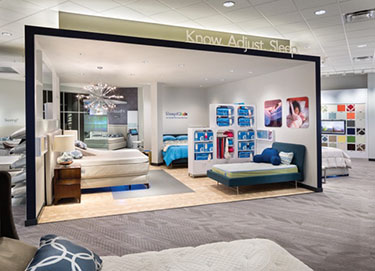
“With our LampFree technology, store managers could now expect to operate their projectors for up to 20,000 hours without ever changing a lamp,” says Joseph Gillio, Senior Director, Strategic Planning and Marketing for Casio America. At Sleep Number, where the projectors run 12 hours a day, seven days a week, that’s more than four and a half years without required maintenance. “And our sleek form factor fits nicely into the displays," Gillio adds.
Today the IndividualFit process, which together with the sensor map and signage screens allows sales people to gather client information, runs on a Dell All-in-One computer mounted, with its 24” display, on an arm next to the Sleep Number bed. At the foot of the bed is a 95” diagonal glass panel from Spyeglass, with 3M Vikuiti Rear Projection Film applied. The film provides high-gain, high-resolution two-sided viewing from the bed and from the store. In addition, some of the stores have a second screen that allows clients to view the pressure point demo by looking straight up from the bed.
“The systems are networked, so we can push software updates out of Minneapolis,” Gearhart says. “We capture the clients’ names and email addresses as well as their Sleep Numbers, and we send an email with their pressure map image, which they can share via social media. The system also connects to our CRM stream and acts as a lead capture device.”
Gearhart and her team continue to innovate, tweaking the software, hardware and store designs on an ongoing basis. In the process, they have won multiple awards from the Association of Retail Environments.
“Casio LampFree has served us well, giving us more longevity and a better image,” she says.
It has helped tell the story of a simple, but revolutionary product idea to a wider and wider audience.
